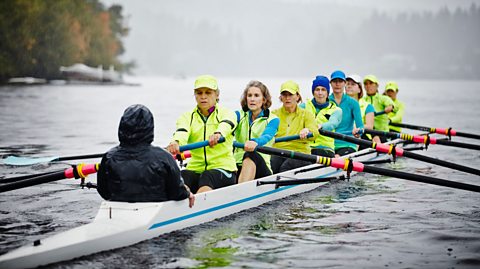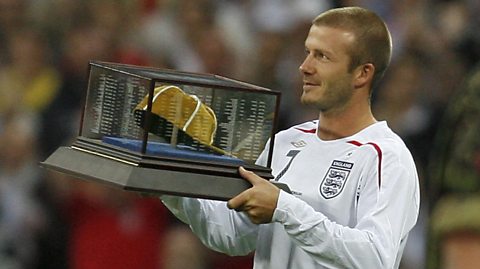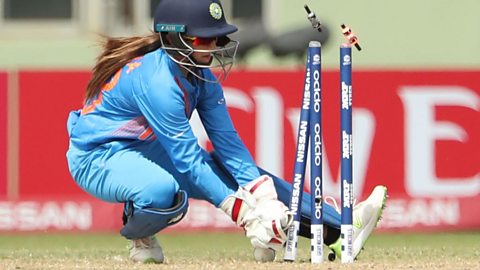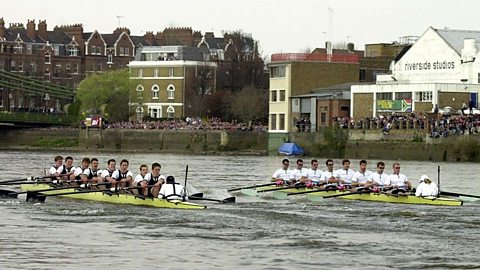From the Boat Race to Olympians going for gold on water - a rowing contest can be an exciting spectator sport.
If you're coming to these events new, you may hear some technical terms that sound a little confusing - but don't worry - we're here to help. You can learn some of the key rowing terms in our ┤¾¤¾┤½├¢ Bitesize jargon guide.
Oars
Without these, there wouldnÔÇÖt be much of a race as the crews would be stuck at the starting line. The poles with paddles on the end that propel the boats through the water come in different sizes, and depending on the event, rowers use either one or two.

Blade is another word for an oar. A smaller version of it is called a scull, used in the sculling event. Sculling is easy to spot as it involves each rower using two oars (one in each hand).
Rowing with a crew where each member uses one oar is known as sweep rowing. The blade oars alternate between the stroke side of the boat (on the left, or port side) and the bow side of the boat (the right, or starboard side).
Whether itÔÇÖs a blade or a scull, the end of the oar which enters the water is called a spoon and is best identified, especially at the Olympics, by being decorated with the flag that represents the crew or rower.
Cox Box
The cox is the only person on a boat during a race who doesnÔÇÖt hold an oar. Although it may look as through they simply shout encouragement to the rest of the crew, a cox also has to steer the boat by guiding the shipÔÇÖs rudder, keep motivation as high as possible and also offer feedback after the race.

In the absence of the team coach, a cox, or coxswain to give them their full title, can also step into this role. Steering can be manual, by moving a cable attached to the rudder, or by shouting to the crew to apply more pressure to the on the stroke or bow side of the boat.
When youÔÇÖre out on the water at a regatta with rival crews either side and noisy crowds on the bank, it can be difficult for the cox to communicate with the entire crew, especially if itÔÇÖs eight-strong. This is where a cox box comes into play. ItÔÇÖs a system of microphones within the boat that enable everyone to hear the cox as clearly as possible. If your mind's eye is throwing up a picture of a cox using a megaphone to drive their crew on, it wouldn't be wrong. These are still used as a cheaper alternative to the cox box.
Catching a crab
Not quite the skill which would be the envy of fishing crews everywhere, this is all about when a rowing stroke goes wrong.
The cycle of a stroke has to be kept at the right rhythm, especially if the boat has a large crew when itÔÇÖs vital everyone synchronises to keep the vessel slicing through the water at speed. If something goes a bit wrong and a rower doesnÔÇÖt lift the oar from the water in time, itÔÇÖs known as ÔÇÿcatching a crabÔÇÖ. With the oar being in the water when it should be out, it acts as a brake and slows the boat down, potentially losing time in a race situation. ItÔÇÖs a sign of a good run if a crew crosses the finish line without catching any crabs at all.
Stroke seat
One of the most important seats on a boat. Whoever sits here (at the back of the craft) is the pacesetter and determines the stroke rate for the rest of the crew.

In a coxed race, the cox is the only person the occupant of the stroke seat sees. They face the cox and have their back to everyone else. If a boat is coxless, the only view from the stroke seat is the back of the boat and the water as the crew cuts through it. In those circumstances, the stroke is the last of the crew over the line as well.
Feathering
This delicate sounding term is actually a rowing action.
When the rower pushes the oar handle down, the blade comes out of the water. As the blade emerges, the rower rotates the oar handle by around 90 degrees, making the blade once again parallel to the water.
This technique is known as feathering. ItÔÇÖs an important skill to master as it helps to reduce the air drag on the blade.
The opposite technique is called squaring the blade (where it goes perpendicular, rather than parallel). By squaring the blade, the area affected by wind can increase, which in turn can lead to a loss of boat speed.
And while those speed differences might only seem small, every second and split-second can count in an elite race.
This article was first published in March 2021 and updated in July 2024
The origins of football jargon
From hat-trick to volley, learn where some of the most popular football lingo comes from.

Origins of cricket jargon
What do ducks have to do with cricket? Find out here.

The things you never knew about the Boat Race
The controversies and records in the famous university clash on water.
